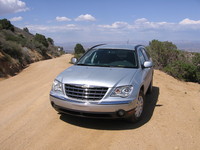2007 Chrysler Pacifica Review
SEE ALSO: Chrysler Buyers Guide
CHRYSLER PACIFICA IN SEDONA
Hiking in the Red Rocks
From a Shunpiker's Journal
By Steve Purdy
TheAutoChannel.com
Detroit Bureau
We’re just back from Sedona - Arizona’s second most popular tourist destination, next only to the Grand Canyon. We’ve been there a half dozen times over the years, but not nearly often enough. This is one of our favorite locations to hike, explore, meditate and test cars. Sedona is one of those destinations of which we could never get tired.
Sedona’s charm as a vacation destination is multifaceted. Surrounded by magnificent red rock formations with fascinating geological and spiritual significance, the village of about twenty-thousand souls (rapidly growing, of course) is nestled into the verdant riverbanks where Oak Creek spills out of its canyon into Verde Valley. Spirituality permeates the red rocks and the culture, making guests and locals alike appreciate life differently than they did before coming to this beautiful place.
This trip we tested the Chrysler Pacifica, a crossover SUV or CUV, loosely based on an E-Class Mercedes architecture infused with some Chrysler minivan elements. We’ve wanted to evaluate this good-lookin’ vehicle for some time now. Northern Arizona was a great place to do it. We didn’t do any serious off-roading, of course, but we got onto some dirt and rock roads. The Pacifica, after all, is a cruiser, a road car, a sleeker, more sophisticated mini-van, not an off-roader. Being a Chrysler we expected it would be luxurious and well-designed. We were not disappointed in that regard.
GETTING THERE
The shiny, silver, six-seat Pacifica was waiting for us in Phoenix with its front doors open invitingly, wide rear hatch lifted, third seat folded flat exposing plenty of space awaiting our cargo, and AC on full blast fighting the 95-degree heat. So what if it’s dry heat. It still feels like 95 to me. The good news is that it’s typically 15-degrees cooler around the red rocks of Sedona where we’re headed.
A light lunch of fresh fruit and a veggie omelet and at our favorite downtown Phoenix natural foods breakfast/brunch/lunch eatery called First Watch fueled us up for the drive north. We discovered this small family-owned chain of restaurants specializing in the creative use of healthy food stuff when we passed through Charleston, WV a few years ago. Now we patronize them whenever we are in one of the few cities where they are located.
First impressions are favorable. I’ve always liked Pacifica’s bold rakish lines defining the long van-like body since I first saw it at the Detroit auto show in about 2004. Pacifica was one of the first products codesigned by the Germans and the Americans after the DaimlerChrysler marriage. Overhangs, for a vehicle this size, are admirably short with big tires filling big wheel wells – 17-inch, 65-series tires standard with 19-inch optional. The longitudinal lines defining the hood, the classic grille and sturdy stance shout “Chrysler” but not “soccer mom.” Rather we get the sense of an upscale people-hauler.
 |
Northbound on I-17 we finally broke away from city traffic and began to cruise at around 75 mph. Power feels more than adequate from this 4-liter, 245-horsepower V6. That’s only a few hp more than the previous underpowered 3.5-liter unit but has considerably more grunt with 262 pound-feet of torque. The six-speed automatic ‘Autostick’ (manual mode) works well keeping the Pacifica powered positively up and down the hills. The cruise control holds steady and compensates well, up and downshifting for the steep grades without drama as we climb steadily onto the first plateau about two-thousand feet higher than the city.
Ride and handling were comfortable and unremarkable – not too stiff, not too soft. On the highway we felt perfectly sturdy and stable with decent steering feel. The ergonomics of driving were good - that is, seating position, steering wheel design and controls. I’m especially fond of the power seat controls high on the door panels, rather than tucked down on the side of the seat base where it would be hard to reach. As elevation increased and we headed into the high desert the saguaro thinned and then disappeared
After a just more than an hour of scenic driving we began to descend the mountain toward Camp Verde and we got our first distant view of the red rocks, still 30 miles away. We cut off onto SR 179 and soon spotted Bell Rock, first of the dramatic red rock formations that define this part of Arizona. Construction was oppressive as we crept though the village of Oak Creek, but that was not a problem for the Pacifica which is pleasant to drive slowly. At least from the front seats we had a nice panoramic view of the scenery through the huge windshield. Like other such popular vacation destinations, this area is growing faster than the infrastructure causing traffic to barely move at busy times of the year.
Highway 179 joins US Route 89A just where the latter bends to the west toward Cottonwood having come through steep, dramatic Oak Creek Canyon from Flagstaff to the north. The locals call this the ‘Y,’ though really it’s a ‘T.’
A left at the ‘Y’ at downtown Sedona onto SR 89A West brought us to our digs for the first few days at the Sedona Summit Resort, located at the top of the last rise at the western edge of town. The Summit is in its fifth phase of development with each phase getting more luxurious and taking more advantage of the hilltop views of the red rock structures.
OUR DESERT DOCENT
The kind folks at the tourist bureau set us up with a guided tour to get us acclimated to the area and to provide some colorful background narrative describing the essence of the red rocks of Sedona. The yellow Jeep folks (called A Day in the West) have dozens of tours exploring all the nooks and crannies of the red rocks and trips to the Grand Canyon. In fact, they host more than a dozen different tours not only in Jeeps but on horseback, or via helicopter, stagecoach or motor coach.
The company was started in 1949 by the Bradshaw family. The original Mr. Bradshaw shot amazing photos in black and white of the movie people who frequented the area producing westerns after WWII. The photos are on display in the office as well as a pet tarantula and a scorpion, both of which they will take out so you can have a close look – if you dare.
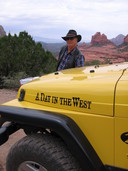 |
“We’re right on the northern edge of the Sonoran Desert, the hottest desert in the US,” Big John said in his booming voice, loud enough to be heard easily by all of us in the back of the Jeep. “The Mogolan Rim, extending from the southern Arizona/NM boarder to just about the Grand Canyon, is the edge of the Colorado Plateau where tectonic plates have collided for a couple hundred million years pushing up the Rocky Mountains. You can still buy beach-front property here, in a sense,” he claims. “At least there are still erosion marks in the sandstone where ancient seas with massive tides lapped against the cliffs.” While not a trained geologist, or naturalist, Big John, like most of the gentle people who settle here, have made special efforts to assimilate the knowledge and appreciation of this unique environment.
Big John is one of many fellows and a few gals here in Sedona driving yellow Jeeps. There are also Pink and brown Jeeps, and a few H1 Hummers as well, that take tourists and travelers into the back country to see the natural beauty that makes Sedona the phenom of tourist destinations. Big John was drawn here about 5 years ago after an early retirement from a career in steel production. It would be hard to distinguish him from the musty, dusty cowboys who grew up here – if there are any. Like the people at many of the more exotic resorts the majority of the folks came from somewhere else not too long ago. We’ve not found a local person yet, though, who maintains an urban mentality.
Check out Big John and “A Day in the West” tours in downtown Sedona, at 800-973-3662 and at www.adayinthewest.com, and see those amazing photos at www.bradshawgallery.com.
FIRST HIKE
The Coffee Pot restaurant is one of the most popular breakfast spots in town for good reasons, like the 101 different omelets on the menu. They don’t have nearly enough parking but the food and service are great. We fueled ourselves up for our first hike. My pretty blonde’s green chili omelet and my blueberry pancakes were so good we had to share both. If we get there early next time we’ll get a table on the patio facing Coffee Pot Rock glowing in the morning sun.
We abandoned our first plan to hike the 3.3-mile loop trail around Airport Mesa that affords panoramic views of the entire valley when we encountered a gaggle of senior hikers just preparing to hit the trail. There must have been a hundred of ‘em – perhaps an Elder Hostel tour. They all appeared to be in their mid-70s, every one equipped with proper gear - a walking stick, large-brimmed hat, big bottles of water and hiking boots. They almost looked to be in uniform. Perhaps we’ll do this hike later in the week.
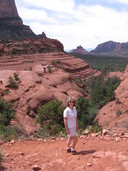 |
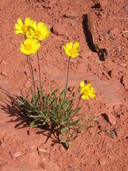 |
Our second home away from home is a luxurious time-share condo at Fairfield Sedona – large one-bedroom unit with great views of the Airport Mesa and Coffee Pot Rock from the large east-facing balcony – a great place to sit and write.
SECOND HIKE
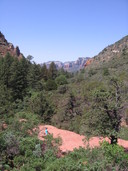 |
Secret Canyon Trail winds steadily upward along the banks of the dry steam coming out of the canyon. The trail crosses the dry rocky steam bed a half dozen times and often climbs a hundred feet above as the elevation increases and the flora slowly changes character. We hiked in a bit more than two miles and probably accomplished most of the elevation but ran out of energy and water. With dramatic views of the back side of the Mitten range and the beginnings of the Verde Valley we burst out of the trees on the up-slopes and we began stumbling along the rocky trail, because we were so engrossed in the views. The round trip took nearly 4 hours. If I was 100 pounds lighter and had an extra gallon of water we would have gone to the end, 5.5 miles in . . . really.
Danny also put us on to a secret place to eat as well. Clinging to the cliff, tucked into the back of a commercial strip just a few buildings south of the ‘Y’ we found The Hideaway - and it was really hidden away. Kegn Hall was managing and hosting for her parents, Marc Spector and Syri Hall who started the little Italian place 27 years ago. Because the majority of their patrons are the Sedona locals they have a more balanced business year around. We sat at a patio table overlooking the tops of the trees - mostly huge sycamores and cottonwoods - that grow thickly from the wet soil around Oak Creek. A handsome middle-aged guy played guitar and sang James Taylor tunes. For 10-bucks my pretty blonde and I split what they refer to as the “Anti-pasta Salad for One” It comes loaded high on a platter with three meats, olives, two kinds of beans, a wonderful Italian dressing and a couple big hunks of their special cheese-topped garlic bread. We were stuffed. They serve that salad for two and for four for a few extra bucks, but the small was plenty for the two of us. With lasagna, baked manicotti, three versions of fettuccine (including with clams), ravioli Florentine and a bunch of gourmet pizzas there is nothing on the menu for more than 13 ½ -bucks except the biggest salad and the loaded pizzas. What a find! Hope we’ll get back there again.
THIRD HIKE
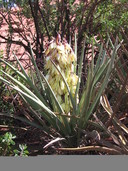 |
As we returned to the gravel trailhead parking lot an older couple was poking around in the back of their Pacifica Limited. The nearly 80 cubic feet of interior space (with second and third row seats folded flat) was stuffed so full it looked like it might explode. A pod mounted to the roof rack supported her contention that they were in the process of moving. I asked how they liked their Pacifica. He said he loved it but it is a bit underpowered. He also knew that a new engine for the ’07 is reputed to have cured that problem. Then we talked fuel mileage. He said they’ve gotten in the mid-20s easily on trips and have been getting just over 20-mpg with that huge load on. We’re getting about 17.5 mpg with our Pacifica with the new engine, and no load. EPA estimates are 18/city and 25/highway. They may have been beyond the recommended max of 900-lbs payload.
It’s dinner time. Our philosophy is that when looking for the best Mexican food, find the place where the Mexicans eat. Casa Bonita fills that bill. Located in a strip mall in West Sedona, it appeared that about two-thirds of the patrons, at least while we were there, were Hispanic. And the food was really excellent and reasonably priced. My crab-filled enchilada was covered with green chili sauce and melted cheese was drizzled across the runny beans and the embellished rice. A tiny salad with plenty of aromatic fresh cilantro balanced the plate. My pretty blonde’s chimichanga, while a bit Anglo-cized, made her happy. She brought half of it back to the condo to snack on later.
CIRCLE THE VALLEYS – SMALL & BIG – HIKE FOUR AT CARROLL CANYON
 |
We then circled the Verde Valley – perhaps a two hundred mile drive - with the Pacifica. We had been so busy hiking around the village we hadn’t had the chance for a good, long drive. The Verde Valley extends from Sedona southeast past Camp Verde to northwest past Jerome and Cottonwood and southwest to Prescott (pronounced like biscuit, don’t say press-cot).
 |
The Pacifica’s suspension got a good workout on this intermittently wash-boardy, rocky and sandy dirt and gravel road. All Pacificas come standard with an independent McPherson strut system in front and a five-link self-leveling design in the rear. The chassis and suspension soaked up the rough stuff admirably. We felt just a hint of slide on some of the tighter switchbacks with loose sand and dirt. As the rough miles went by under our big tires we rode in perfect comfort.
Once through the Cherry Ridge we turned right and passed through Prescott then north onto Highway 89A toward Jerome. Just north of Prescott is an amazing area of huge granite formations jutting out of the otherwise nondescript terrain. The colors and grains and shapes are like something from another world – not really spooky, just fascinating. A local park and an interesting neighborhood coexist entirely within these formations. I’m intrigued to think that we could buy a lot or a home right in the center of these cool rocks.
Highway 89A becomes the Mingus Mountain Road, often used for sports car commercials because of its winding, twisting, swaying beauty as it sweeps to Jerome, along the edge of the tree-covered Mingus Range. After about twenty miles of this excitement we suddenly found ourselves on the top loop of the street through this most vertical city in the west, an old mining village a mile up the side of a mountain. Jerome is a place where the first floor of one home overlooks the roof of the next one below. In fact, from our lunch table by the window at The Haunted Hamburger (in a verifiably haunted old building) we looked out over the valley with Sedona barely visible 28 miles to the east. We could have jumped down about 15 feet to the roof of the two-story building one street below.
By the way – if you’re a fan of old trucks you’ll love the collection of old Internationals at the touristy “Ghost Town” at the end of the dirt road that takes off by the Jerome fire hall. There must be at least 50 of them including a car hauler from the 30s.
HIKE UP THE WEST FORK – FIFTH HIKE
 |
SUNSET – MOONRISE
 |
The moon had been approaching full all week and we had some lovely views of it – a little flat on one side - in the high desert sky. Because Sedona restricts ambient light the night sky is always vivid. Well, just as we stepped out of the condo we could see that the moon was about to emerge over the crest of Airport Mesa about a mile southeast of us. We watched in giddy anticipation then gasped as it began to emerge slowly, its intense white light looking molten where the image of the moon met the horizon of the ridge. It reminded me of watching the sunrise on the Carolina coast as the molten sun emerges from the water. Slowly it climbed, entirely full, showing off its surface patterns in soft creamy gray and surrounded by a pinkish halo about twice its diameter. In all my travels I’ve seen only one moonrise more dramatic. That was on the island of St. Thomas. Remind me to tell you about that one sometime.
THE FINAL HIKE
Vultee Arch was sort of a farewell hike on our last day. The trailhead is at the very end of Dry Creek Road, or Vultee Arch Road, depending on which map you’re reading. Like every other hike this week we encountered interesting people ready to chat and talk about the beauty of Sedona. This time, after about an hour of a gentle, steady uphill pull among more wildflowers, a couple of burn areas and a few adolescent bull thistles to punctuate the trail we came to some big flat red rocks with a view of a formation about a quarter mile away across a deep gulley and a hundred yards up a steep slope that looked like a modern car’s door handle. Called Vultee Arch it is named after Mr. and Mrs. Vultee, pioneers of aviation in the area who crashed their biplane near that spot in 1938.
 |
LEAVING THE RED ROCKS AND SUMMING UP THE PACIFICA
 |
We were not surprised that so many strangers were so inspired to talk about the experience of the area. We were a bit surprised, though, at how many people admired and asked about the Pacifica. It is certainly attractive and unusual with its extra wide track (66-inches) and brash but classy styling. Nearly every time we stopped someone asked about it.
One experience comes particularly to mind.
We stopped in at a real estate office to ask a few questions about time-shares and local real estate. We were ushered in to see a most charming pair of agents, Jack and Lisa Frost. Jack immediately asked if I was the person who just drove in with that Pacifica. So that began an animated discussion that lasted more than an hour about the comparison between the Pacifica and his Durango, our respective love of old and new automobiles, his history as a musician and on and on. Our wives continued to remind us that we had come in to talk about real estate, but of course, that wouldn’t be nearly as much fun as talking cars.
The Pacifica comes in three iterations, plain vanilla, (they just call it Pacifica), the Pacifica Touring, and Pacifica Limited. Prices start at $25,190, $28,330 and $34,505 respectively. The latter two come with the 4.0-liter engine and for about a couple of grand extra you can have all-wheel-drive. They all come with lots of air bags, standard ABS, Traction Control, tire pressure monitors and other essentials and, of course, you can load them up with extras if you like. My sense is that it is an excellent contender in the mid to full-size CUV market. According to the Chrysler Website there are some significant incentives on the vehicle now as well.
Warranty is about average with 36-month/36,000-miles on the vehicle including powertrain and 100,000 miles on rust through.
If you’d like to visit, or just learn more about Sedona and surrounding areas, check out this helpful Website: www.arizonatourismcenter.com Phone: 877-444-8044
© Steve Purdy
Shunpiker Productions
All Rights Reserved



